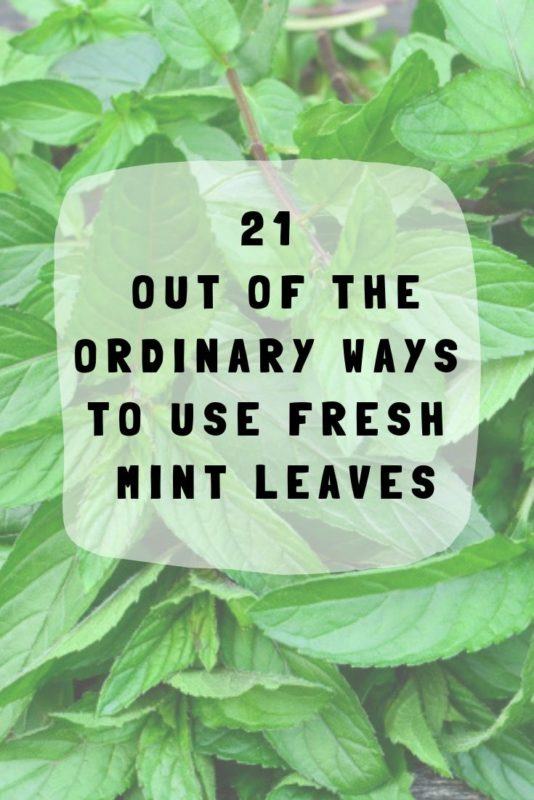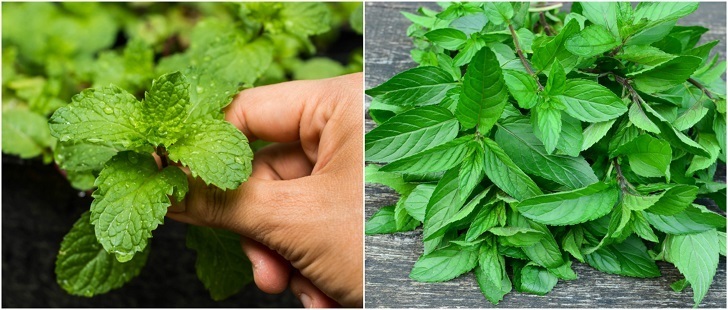
Delightfully fragrant and relatively low maintenance, mint is a joy to grow – earning its place in any kitchen herb garden.
Mint can, however, be a little invasive and spreads quickly – so don’t be surprised if you end up with an abundance of this zesty herb at the end of the growing season.
Never fear though, your bounty need not go to waste!
Here’s everything you need to know about harvesting and using homegrown mint.
How to Harvest & Prepare Mint
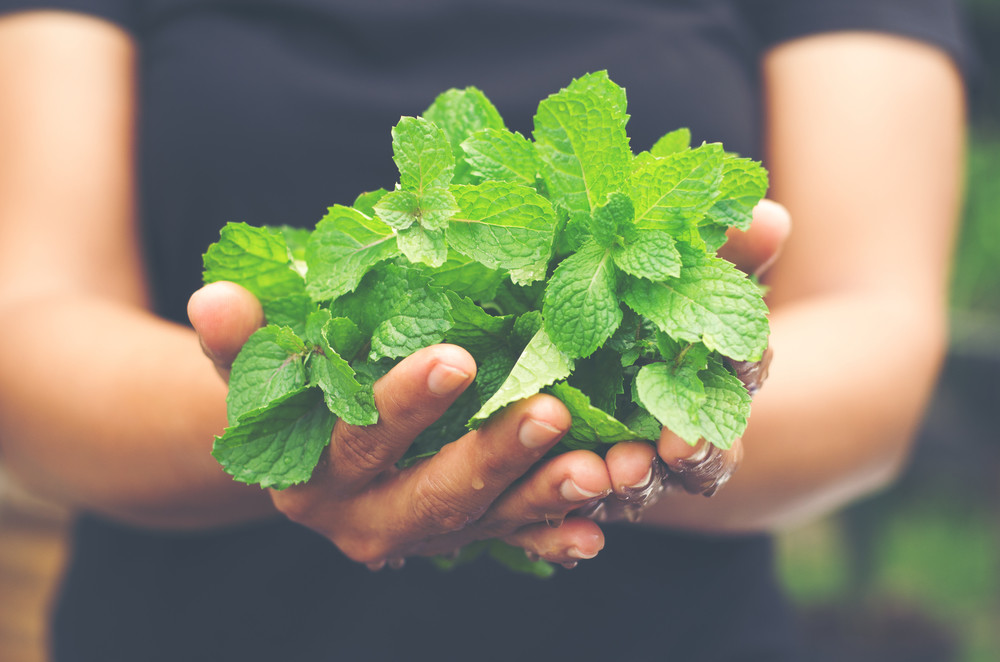
Keep your mint plant at its best by frequently harvesting small amounts of the leaves for your culinary and medicinal uses. Not only will you be encouraging the herb to fill out, but young leaves have more flavor than the older ones.
Pick off the leaves as you need them, remembering to harvest no more than one third of the entire plant at any one time until the end of season.
If your plant is growing outdoors, then right before it starts to flower, cut the stems to one inch from the ground. You can harvest one mint plant two or three times in one growing season.
Mint sprigs will keep for a few days in water, and the leaves can be stored in the refrigerator for a couple of days, although it’s best to use them immediately or preserve them by freezing or air-drying.
Here are some fantastic ways to use your beautifully fragrant mint leaves:
As a Food:
This sweet, zingy and refreshing herb can impart some serious flavor to a dish. Some of the more popular culinary uses of mint include:
1. Vinegars & Oils
Preserving its flavor through a simple vinegar or oil infusion is one of the most convenient ways to use up mint leaves.
Apple cider vinegar and peppercorns work with mint in this pungent vinegar that’s perfect in salad dressings or homemade flavored mayonnaise. A lightly flavored mint oil – like this one – is idea for drizzling over salads, fresh fish, rice or vegetable dishes.
Pair the sunny fresh flavors of tart lemon and cool mint in this lively dressing or try a raspberry variation for summer salads.
2. Soups
While mint isn’t the first herb most of us would turn to when flavoring broth, it can enliven some fantastic summer soups.
A fresh, creamy and healthy pea and mint soup is always a winner; while orange, carrot and mint make a more surprising but equally delicious combination.
Refreshing and crisp, a chilled watermelon and mint soup is ideal for patio parties, as is this cucumber and mint version.
3. Sauces, Chutneys and Dips
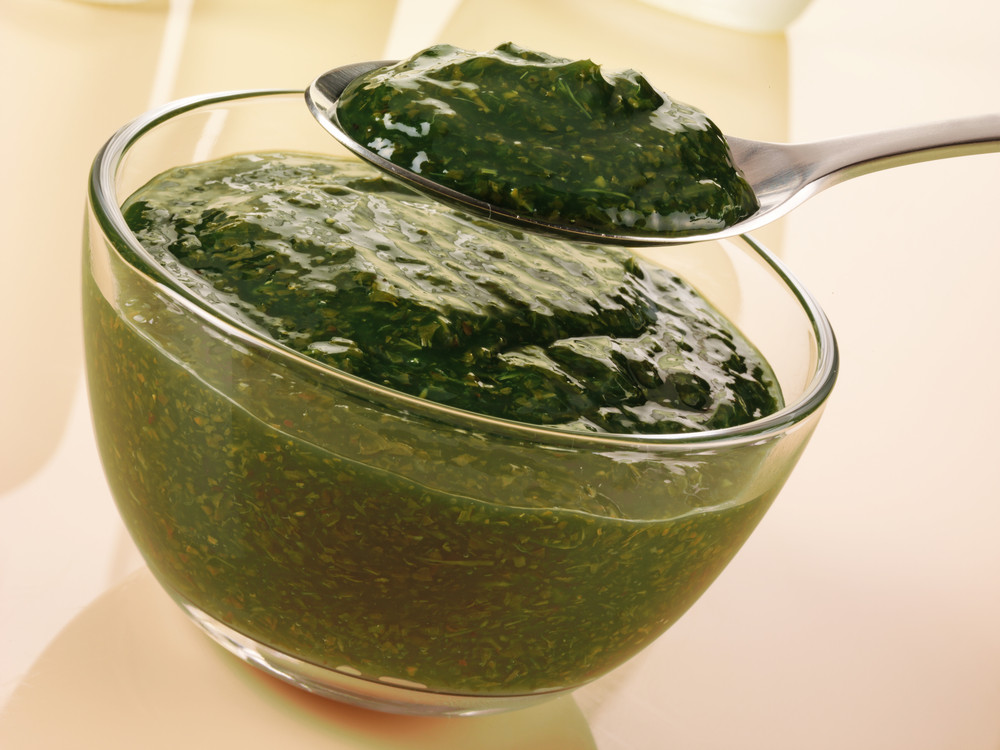
Mint plays the starring role in some delicious sauces and dips. For a classic English flavor, try this traditional mint sauce with roast lamb. Many Indian dishes will pair exceptionally well with a cucumber and mint raita, or this mint chutney.
For a new take on a classic, whip up a mint pesto using parsley, garlic, lemon and oil. It’s ideal for flavoring all manner of meat or vegetable dishes.
4. Vegetable Dishes
In addition to drizzling mint infused oils or vinegars on your meals, or pairing them with a minty sauce, why not add fresh mint leaves directly to your dish?
Be inspired by these Moroccan mint roasted vegetables or these delicious chargrilled vegetables with mint and feta cheese.
5. Salads and Sandwiches
Mint is an often neglected herb when it comes to adding a kick to salads or sandwiches – but it really does deliver! It’s delicious chopped up with other greens, and always works with tomato or cucumber.
For something a little more adventurous, try this fresh spring salad with quinoa, corn and mint; or a lemony potato salad. Of course, more traditional mint inspired salad recipes include this delicious tabbouleh or a feta, lime and mint dish.
Mint works in some sandwiches too – like a crisp English cucumber sandwich or a feta cheese filled pita bread.
6. Noodles and Pastas
Summertime pasta and noodle dishes can all benefit from the addition of fresh mint – bringing their light and sweet flavors to a new level.
Play around and see what works for you, or keep it simple and try a creamy avocado pasta with mint; or this tasty lemon, mint, pea and garlic pasta. Noodle lovers will enjoy soba noodles with vegetables and mint; while gluten free and raw foodies can enjoy these guilt-free cucumber mint noodles with ginger dressing.
7. Desserts
Because chocolate and mint are a match made in heaven, desserts and sweet treats are where mint really shines. The recipes using mint are endless – from milkshakes and ice-creams to cupcakes, cakes and cookies – so those with a sweet tooth should have no trouble using up their mint harvest.
Some sweet ideas include this Emerald mint milkshake (perfect for St. Patrick’s Day!), this cool green mint cake; or some minty chocolate chip cheesecake brownies.
For some lightened up (and vegan) dessert ideas indulge in healthy mint chocolate fudge; creamy and dreamy peppermint patties or a fresh mint sorbet. Of course, you can’t go wrong with a fresh fruit salad garnished with homegrown mint sprigs.
8. Drinks
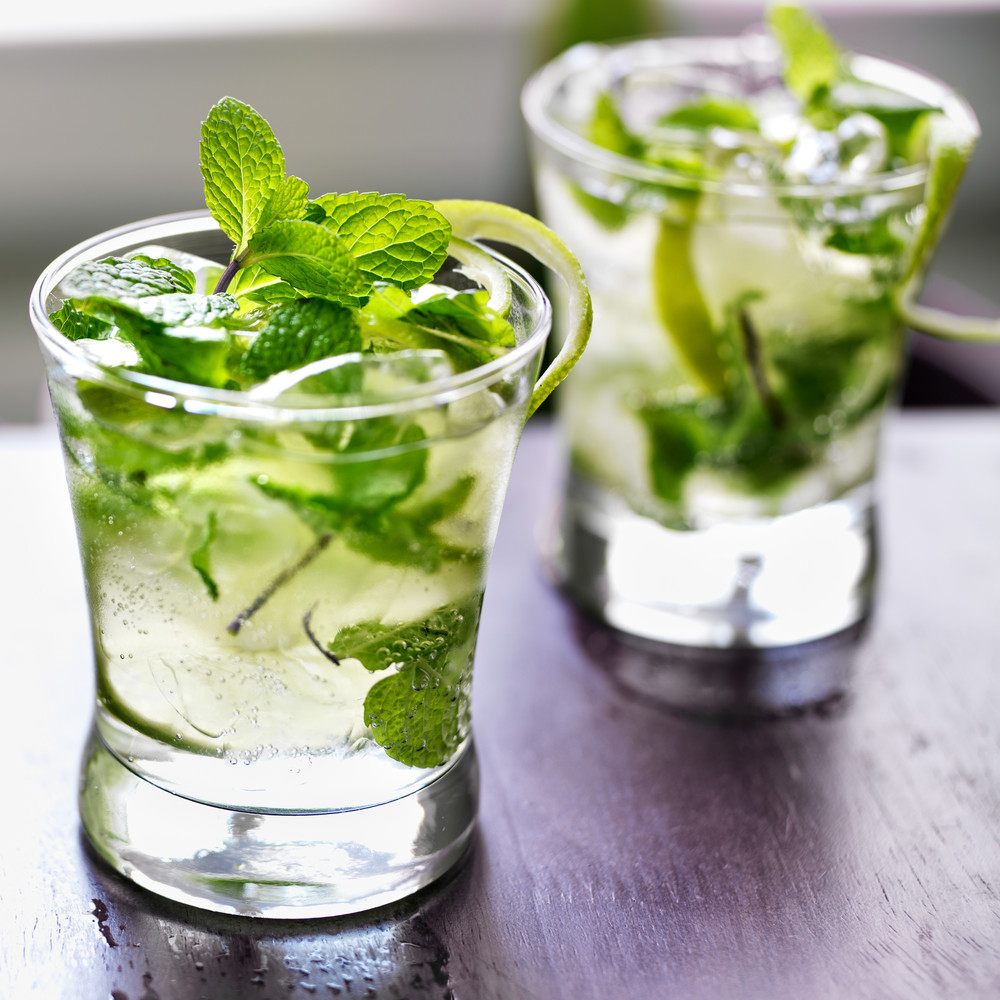
Some of the most refreshing summer drinks are based around mint – think mint Juleps or the classic mojito. For something a little more complex, try a verbena mint cocktail or a delicious Lady Grey tea, lemon and mint vodka drink (which can also be made alcohol free).
Other delicious non-alcoholic mint drinks include a minty lemonade or a cucumber, apple and mint smoothie – the perfect way to start the day.
Of course, a cool pitcher of water infused with lemon or cucumber slices and fresh mint leaves may be the most refreshing thing you drink all summer while simple mint ice cubes add flavor and fun to any cool drink.
As a Medicine:
Mint is one of nature’s most valuable herbal remedies – here’s how you can harness its therapeutic properties:
9. Mint Essential Oil
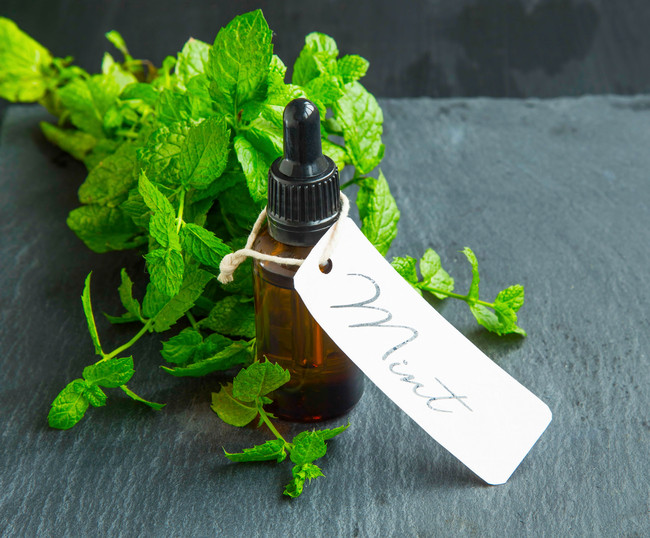
Distill your very own mint essential oil from your organic and homegrown plant and reap its many health benefits – including relief from nausea, stress, indigestion, respiratory problems, headaches, allergies and more. This tutorial provides a step-by-step guide to making your own essential oils.
For an easy to make but less potent alternative, simply infuse mint leaves in a carrier oil like jojoba or olive for three to six weeks, leaving in a warm and sunny place. This oil can be used topically in many of the ways you would use the pure essential oil.
Make sure to check out all these incredible uses for peppermint oil.
10. Stress Relieving Bath
Bathing in soothing warm water is one of the easiest and most blissful ways to relax and unwind after a hard day. But adding a little mint oil or a couple of handfuls of fresh mint leaves to the tub may double its stress relieving effect – the menthol naturally present in the mint acts as a muscle relaxant, helping work out stress induced aches and pains.
You could also make your own refreshing herb soap using fresh mint from the garden and peppermint essential oil – you’ll find the recipe here.
11. Quell Nausea and Aid Digestion
According to the University of Maryland, peppermint helps to soothe an upset stomach and aid digestion by relaxing the muscles of the digestive tract. It’s also said to make the flow of bile more efficient and act as a carminative, meaning it helps to ease gas and associated symptoms.
For maximum relief, steep one teaspoon of fresh or dried peppermint leaves in a cup of boiling water and drink. Repeat four or five times a day, between meals.
12. Natural Body Deodorizer
Antiperspirants and deodorants are loaded with toxins which can cause health issues, and damage the environment. Why not aim to smell sweet naturally instead by eating more fresh mint?
Herbs like mint, basil, parsley, sage and rosemary are all said to be natural body deodorizers.
Learn about the toxic effects of deodorant, and discover more ways to reduce your body odor naturally, in this post.
13. Improve your Work and Workouts!
Whether you’re looking to supercharge your time at the gym, or simply become more alert in the workplace, then start utilizing the powers of your peppermint plant.
Research from the Wheeling Jesuit University in West Virginia found that athletes who sniffed peppermint during exercise ran faster, had greater grip strength and could do more push-ups than those who did not.
Smelling mint can help in everyday life too – it can improve clerical work, including typing accuracy and speeds, as well as helping you stay more alert while driving.
It’s just another reason to bring a flask of homemade mint tea on your morning commute, or stash a vial of mint essential oil in your gym bag.
14. Curb Your Appetite
Dieters can use the power of their potted mint plants to curb their hunger!
When researchers looked at the effect of peppermint on hunger levels, they found that simply smelling the peppermint led study subjects to eat ‘significantly fewer’ total calories, calories from saturated fat, total fat and sugar.
Participants also rated their hunger levels and food cravings as significantly lower than those who did not inhale the peppermint.
The next time hunger pangs strike, try chewing on a few fresh mint leaves or adding your homemade oil to your essential oil diffuser.
15. Oral Health
Mint is a natural anti-microbial agent and breath freshener, making it the perfect addition to your oral hygiene routine. For instantly fresh breath, chew on mint leaves, or sip on a cup of mint tea.
You could also whip up your own natural mint-flavored toothpaste and give your teeth a good scrub – helping to contribute to oral health, all while curbing your appetite and avoiding unnecessary toxins found in conventional pastes.
16. Allergy Relief
Mint plants contain an antioxidant and anti-inflammatory agent – rosmarinic acid – which may be a natural way of relieving the symptoms associated with seasonal allergies, according to recent research.
While more work needs to be done on the subject, there’s no harm in upping your intake of fresh mint – through teas or the many recipes listed above – to see if you experience any relief from the typical allergy-induced runny nose and itchy eyes.
17. Reduce the Pain Associated with Breastfeeding
Breastfeeding offers plenty of benefits for both mother and child, but it can frequently lead to pain for the mother. However, a couple of studies indicate that peppermint water or gel may offer some relief!
Researchers found that peppermint water is effective in preventing nipple cracks and nipple pain in first-time mothers who are breastfeeding. Apply cool mint-infused water to the affected area several times daily for pain relief.
18. Headache Cure
Peppermint oil can help reduce the pain associated with tension headaches – it has a cooling effect on the skin, inhibits muscle contractions and stimulates blood flow.
For best results, dilute two to three drops of peppermint oil with coconut oil and rub it into the shoulders, forehead and back of the neck at the onset of symptoms.
19. Clear Sinuses and Nasal Congestion
Drink homemade mint tea during cold and flu season. Not only will the warm liquid sooth the throat but mint is a natural decongestant which opens the nasal passages – perfect for clearing out your sinuses.
Those with chest congestion can also harness the powers of peppermint, thanks to this fragrant and effective chest salve.
Here are 13 other natural ways to ease congestion.
20. Sunburn Relief
When sunburn strikes, calm your angry red skin with an infusion of black tea and fresh mint. The tannic acid in the tea draws heat from the burn and restores the skin’s natural pH while the mint cools and soothes.
21. Repel Insects and Fleas
Keep your home free from pests by placing sprigs of mint by doors and windows (or spraying diluted essential oil in these areas). It’s sure to repel mosquitoes, ants, spiders and more.
Look after your pet’s health too by deterring fleas from their bedding. Tuck two parts fresh mint, one part fresh thyme and one part fresh wormwood inside a small pillow and place it near Fido’s bed.
Pin This To Save For Later
